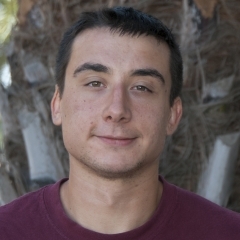
Date:
Location:
Speaker:
Title: Structure and Properties of Phase-Separating Dielectric Soft Media
Advisor: Glenn Fredrickson
Abstract:
The use of field-theoretic representations has emerged as an increasingly attractive and flexible method for describing the statistical behavior of soft materials, granting direct access to thermodynamically-derived structures and properties of interest, while avoiding the computational expense of a traditional explicit particle model. Leveraging the recently-developed complex Langevin (CL) method for full field-theoretic simulation of exact fluctuating field theories, along with the ever-advancing capabilities of academic and industrial computing infrastructures, field-theoretic descriptions of charge-containing soft matter systems – such as polyelectrolyte solutions and polymerized ionic liquids – permit the direct simulation of inhomogeneous, strongly-fluctuating dense fluids of charged species, illuminating the collective thermal motion, and associated electrostatic correlations, of coarse-grained charge-containing molecules. Beyond the already vast materials design space available to this class of field theories, one detail that has thus far been omitted is the explicit polarizability carried by all molecular species contained in a real charge-containing soft matter system.
In this talk, I discuss the construction and implementation of a molecularly-informed field theory for a fluid of polarizable media, assigning ``bead'' molecules with a polarizability via a simple Drude oscillator model. Beads can optionally carry a net free charge or be connected in chains to produce electrolyte and polymer models, respectively. By constructing a simple fluid model of oppositely charged, polarizable electrolyte beads, the model is shown to self-consistently include: short-range van der Waals attractions between polarizable beads, short-range ion-dipole attractions between the net free charge and net dipole moment of neighboring beads, dielectric screening of electrostatic correlations due to intervening polarizable beads, and a long-range Debye-Hückel net ion-ion interaction, subject to the charge-screening and dielectric-screening effects of the bulk fluid.
Subsequently adopting a fluid model of polarizable, charge-neutral beads, the role of an applied electric field in shifting the phase stability of a binary dielectric fluid is explored. When an electric field is introduced, the dielectric constant of the fluid can be directly determined from the statistical behavior of the fluid in the weak-field limit. Its composition dependence determines the applied field-dependent contribution to the miscibility of the fluid mixture, which is cast in the form of an effective Flory interaction parameter. Through the behavior of this parameter, I identify structural contrast between dissimilar molecules as a necessary ingredient to recover the field-induced mixing behavior that has been observed experimentally. This effect is discussed in the context of three classes of binary systems: a simple mixture, a homopolymer blend, and a homopolymer solution.



